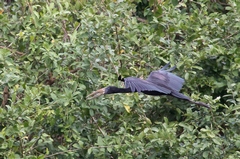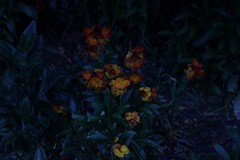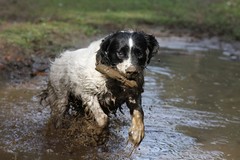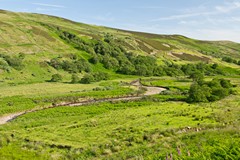ISO is the level of sensitivity of your camera sensor to available light. The lower the ISO number, the less sensitive it is to the light, while a higher ISO number increases the sensitivity of your sensor.

An open-billed stork snapped using my 400mm
lens. The maximum aperture is f5.6 at this
length and so in order to get a high shutter
speed of 1/1600s I had to increase the ISO
from 200 to 1600 which gave me the
equivalent of 3 extra stops of light. Notice
the full size photo is quite grainy and has
some noise in it
With increased ISO, your camera sensor can capture images in low-light without having to resort to a flash. ie. it needs less light to make the sensor register it. But higher ISO has a problem in that it starts to add add grain or “noise” to the pictures. It is usually seen initially in the darker parts of the photo as coloured dots.
The ISO setting sequence shown on camera is usually a doubling up series of numbers:
50, 100, 200, 400, 800, 1600, 3200, 6400 etc.
Some cameras can select intermediate values, but it's easier to stick to this sequence.
From a base of 100, or possibly 50 depending on the make of camera you are using, each increment doubles the ISO which doubles the sensitivity of the sensor to incoming light. Each doubling is the equivalent of one 'stop' of light. The units of the numbers don't matter for the puposes of this discussion. In real life terms this means that you will get a similar exposure on a photo from half the amount of light each time the ISO rating (and hence sensor sensitivity) is doubled, but the picture quality will be progressively degraded.

Roll your mouse over this photo which was
taken with the lens wide open at f4 and a
shutter of only 1/20s and at 800 ISO. It
was still way underexposed, and also blurred
as a result of the slow shutter speed. The
other picture shows the effect of increasing
the ISO to 4000 which results in a much
better exposure. A flash and tripod would be
the best solution here
(click for full sized edited photo)
With modern cameras the difference in quality between 100 and 800 ISO will probably be quite hard to spot unless the image is being really blown up to print.
In low light you may have little choice if it's the only way to get an image. ie. if you have lens aperture set to its widest and the shutter speed slowed as as much as possible before blur/movement becomes a problem, but you are still getting a dark or underexposed image, then your only option is to increase the ISO setting of the camera to try and compensate.
If you are trying to freeze action, the light might not be enough to get the sort of shutter speed you want.
Let's say the maximum you can get is 1/200s at ISO 100 and to freeze the action you want 1/800s. You've already opened the camera aperture up and it won't go any wider.

My lovely assistant Indi. f5.6 and 1/3200s
with an ISO of 2500 enables me to get
good exposure and a high enough shutter
speed to freeze the muddy action. By
boosting the ISO from its normal 200 I
gain over 3 stops of light (equivalent)
If you double the ISO (sensitivity) you will find the sensor will only need half the light to record the image at the same brightness so you could set the ISO to 400 (100 to 200 halves the light needed then 200 to 400 halves it again) and the shutter speed can be quadrupled to 1/800s, because it now needs less time to collect the required amount of light to register on the sensor, which may be enough to to correctly expose the shot.
The key point to remember is that each doubling of ISO speed is the equivalent to one stop of light. Each time you gain a stop of light via the ISO you can half the shutter speed, which loses a stop of light as a trade off for the faster shutter speed, and the nett result is effectively a Zero change in light. So the exposure remains the same.
The effect on picture quality is the only limit.
Shutter speed is vitally important to avoid blur when shooting hand held, especially with a big telephoto lens. The aim is for a minimum shutter speed of 1/focal length that you are shooting at, ie 1/400s if the focal length is 400mm. ISO is a major tool to help you achieve this most of the time. Far better to have a good sharp image of a slightly lower overall quality than a high quality blurred image. Camera manufacturers are constantly improving the ISO performance of their models as they are released, which gives us more and more of an edge to get great photos in less than perfect light.

This landscape was taken with an aperture
of f6.3 as there was nothing in the immediate
foreground that needed to be in focus. This
gave me a Shutter speed of 1/125s and ISO
could be left at 200 for maximun quality
and minimum noise and grain
When shooting landscapes, it is best to go for the lowest ISO possible in order to get the highest quality image and/or fine detail. Of course in some images, such as waterfalls, your intent may be different and you may want to blur the water anyway by having the shutter open for a second or more, in which case ISO is of little concern and it can be left at its lowest setting. It is entirely up to you.
Auto ISO can be used between defined ranges on some cameras. It takes a little bit of the pain away, and manual settings would only be needed in extreme cases, either low light or very fast action.